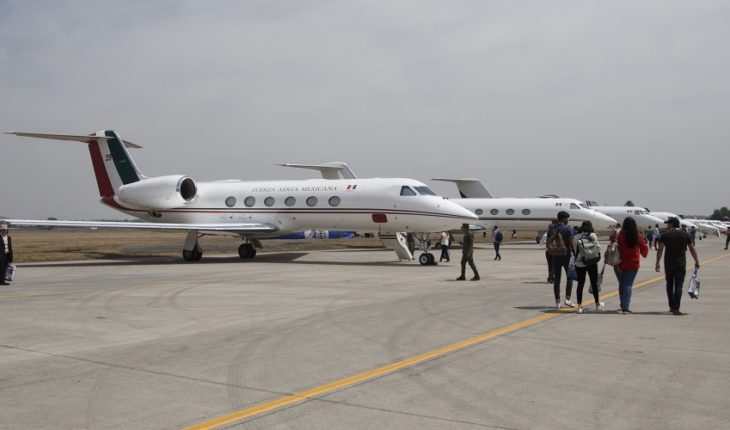The airport that wants to build the government of Andrés Manuel López Obrador in Santa Lucia will generate jobs and economic spillage, but also more pollution in the area, noise, traffic, water problems and even possible damage to temples of different locations.
As referred to the Ministry of National Defence (Sedena) – in charge of construction – in the Environmental Impact Manifestation (MIA) that it sent to Semarnat, and which was endorsed by that agency in considering that the civilian-military airport does not involve a risk establishing 16 conditions, to mitigate and compensate for potential impacts.
Although it is noted that there may be changes in the project, since a Preliminary Master Plan was still available, the Impact Manifestation refers to what the main risks would be, or drastic and direct changes in the way of life of the inhabitants of five municipalities mexiquenses: Zumpango (where the town of Santa Lucia is located), Tonanitla, Tecámac, Nextlalpan and Jaltenco; in total 38 adverse impacts considered significant were identified, for the work that is projected to be ready over a period of three years, although it faces judicial suspensions that would delay its start of operations.
With an estimated cost by the government of 68,367 million pesos, the plan includes the construction of three runways, two for civil aviation (domestic and international flights) and one military; a hotel, a shopping area, warehouses, and a new housing complex for the military.
Lack of water
“A good part of the population will be affected by the water supply to the Airport”, even without even looking at the hotel chains, restaurants and shops that will be located near such construction, is mentioned in the Environmental Impact document presented by Sedena, prepared by the UNAM Institute of Engineering.
“There are local situations that could promote some movement against the airport, as is the sensitive issue of local water supply,” reads elsewhere.
The water supply, the document refers to, will be through wells located inside Military Air Base No. 1. As a mitigation measure, in view of the risk to “the over-exploited aquifer” of the area of St. Lucia, the construction of wastewater treatment plants, the use of rainwater, is considered.
Noise
Considering the noise levels that can occur with aircraft take-off, “up to more than 70 dB(A) at the perimeter of the facility”, is noted in the MIA, “the environmental impact on noise levels in the immediate environment can be considered as adv significant erso.”
The noise impact, he adds, “is the most publicly impactful of all potential airport impacts, manifesting itself in a large number of complaints from residents’ communities in the vicinity of the facility.”
The communities that would resent the most noise, being closer to the take-off and landing areas, are San Miguel Jaltoncan, Santa Ana Nextlalpan, Paseos de San Juan, Santa Lucia, Los Reyes Acozac, and Santa María Ajoloapan.
But not only would there be complaints from people, noise will also scare away the bird population, putting the habitat at risk, “whether in nearby bodies of water or in the forest masses that were located at the project site and area of direct influence.”
The group most likely to be affected by the airport, Semarnat noted, is the “avifauna”.
Tree removal
For the construction of the airport of St. Lucia, it is estimated to carry out the removal of approximately 5,195 trees that were planted for ornamental purposes by Sedena staff, in what has been its air base.
“A portion is considered to be rescuing for relocation to the green areas of the project,” mainly in the area where military facilities are planned to be relocated, reads in MIA.
“Tree specimens” that cannot be salved for relocation, added, “will be disintegrated within the premises and channeled for the manufacture of compost and mulch, which can subsequently be used as a soil enhancer in green areas”.
Poor air quality
The entry into operation of the St. Lucia International Airport Project “will continuously contribute to the emission of pollutants,” the document states.
“Pollutant emissions will be made into the atmosphere by the combustion of turbosin easing in aircraft movement, generating mainly pollutants such as nitrogen oxides (NOx) and greenhouse gases such as carbon dioxide (CO2).
“In addition, a significant increase in the vehicle flow by the activities associated” with the operation of the airport is expected,” says MIA.
One of the conditions established by Semarnat, to approve the Airport, is that an air quality monitoring and monitoring program is established.
And of course, more traffic
“A significant increase in vehicle traffic is expected in the operation stage by the arrival/exit of users… who arrive on their own to the facilities, the motor vehicles that will drive exclusively in the interconnection with the AICM, taxis for the service of users and all related activity in the immediate environment associated with the operation of airport users, mainly hotels and restaurants,” notes the Impact Demonstration.
To calibrate the number of cars that will drive in the area, for the airport of St. Lucia a parking lot with 4,000 drawers is planned.
Among the roads that would be most affected with more transit, the Mexico – Pachuca highway, the Outdoor Mexiquense Bicentenario circuit, and Mexico – Tizayuca are mentioned.
“Special attention deserves the case of Highway 85 (in its Tecámac – Tizayuca section) because of the congestion identified during the field visit and validated with the comments made by the ejidatarios of San Miguel Xaltocan”, the document refers.
Damage to health
MIA indicates that the health of the population near St. Lucia Airport may be affected.
“Health effects from the emission of contaminants and powders will occur during the two years scheduled for the works and in the vicinity of the roads used for the transport of supplies, materials and equipment. This affectation would be controlled and reduced by measures that reduce population exposure, typical of good construction practices, including unit maintenance.”
“The increase in vehicle traffic during the preparation of the site and construction of the airport will also increase the risk of accidents, which the only control that is available is the proper design and signage of pedestrian crossings and warning about the type of vehicles that drive on the roads adjacent to the airport,” is added at MIA.
Risk of anarchic growth
A work the size of the airport of St. Lucia, referring to the MIA, can cause that “the price and uses of land from the land surrounding the Project site, may enter a process of speculation and pressure for the change of its use”.
According to the analysis, there is a risk of “anarchic growth around the airport”, when new shopping centers, lodging and even night time fun are generated, with social implications that can be annoying for the local population.
Indigenous population
The event notes that the indigenous population near the airport will receive more “cultural pressure”, by the interaction that will take place with the new population arriving in the area, “motivated by the hiring of labour in the preparation stages of the site and construction,” although there is also the expectation that they will be able to access jobs or the economic benefits generated by the project.
Read more: Cerro de Paula, near St. Lucia, has 30 archaeological sites, not 3 as INAH official says
Possible affectation of temples
According to the impact statement, there is a possibility that noise and vibrations that may occur by aircraft will affect “in the medium and long term the stability of the structure” of temples in the area near the airport.
“The places with temples that can be most likely affected are: San Miguel Jaltocan, Santa María Tonanitla, Los Reyes Acozac and Santa María Ajoloapan. By proximity Santa Ana Nextlalpan, and Santa Lucia”.
No budget defined for mitigation
“To date, the amount for the implementation of the project’s prevention, mitigation and environmental recovery measures has not yet been defined, but the staff of the Ministry of National Defense is committed to attending immediately any event or event in environmental matter,” reads in MIA.
What about the hill?
In the case of the Santa Lucia International Airport Project, the Manifestation states, “one of the main problems identified in the planning for the location of the runways, is the presence of Cerro de Paula”.
The height of the hill, detailed, mainly affects the location of the southern track, one of the three tracks that are planned to be built.
For that reason, it was established that such a clue should be considered exclusively for military use, it is noted in the document.
Saturation will return…
According to the text presented to the Semarnat, prepared by the Institute of Engineering of UNAM, it is estimated that the airport of St. Lucia, with the increase in user demand, begins to experience saturation problems in just 10 years.
What we do in Animal Político requires professional journalists, teamwork, dialogue with readers and something very important: independence. You can help us keep going. Be part of the team.
Subscribe to Animal Politician, receive benefits and support free journalism.#YoSoyAnimal




